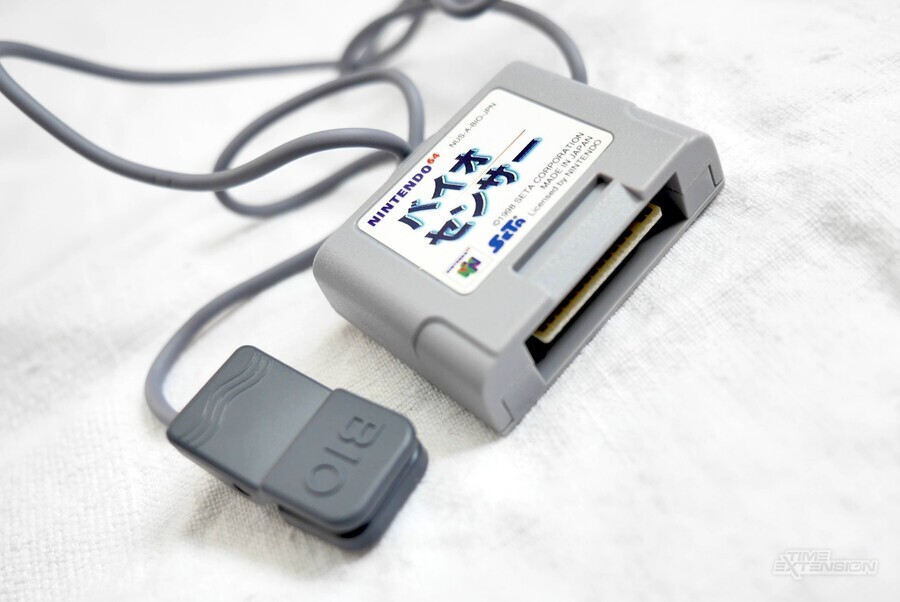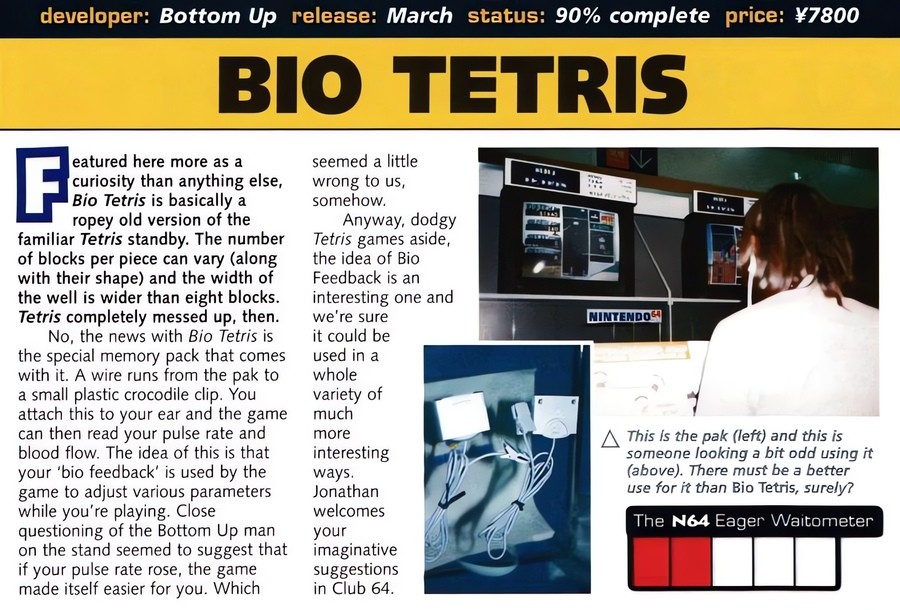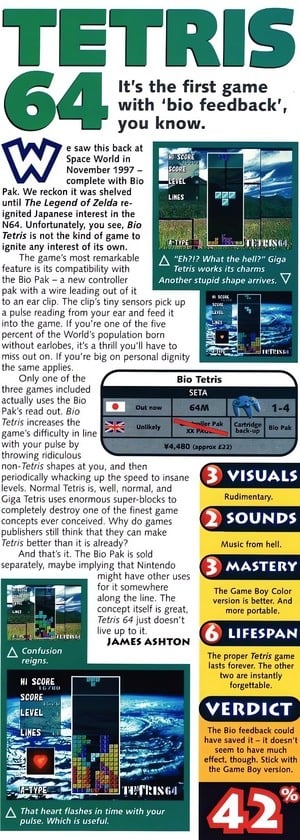
Given the recent trailer for Apple's forthcoming Tetris movie, we at Time Extension naturally acquired one of the oddest Tetris variants to test!
Actually... that's not quite true. After our feature on the Rare HQ, we had a desire for some nostalgia and decided to reinvest in a full N64 set-up, focusing on things missed back in the day. It included an RGB-modded NTSC system, official RAM expansion, Everdrive64 X7, FRAM upgraded official Memory Pak, official Rumble Pak with "no battery" mod, GB Transfer Pak, extra controllers with refurbished analogue sticks, a stack of N64 magazines, and the two crowning jewels in the collection: the Bio Sensor with Tetris 64 and an American copy of Hey You, Pikachu! (At the time of writing, Hey You, Pikachu! is still in transit; the cheaper Japanese Voice Recognition Unit is incompatible with the US cartridge.)
The arrival of the Bio Sensor's arrival coinciding with the Tetris trailer was mere coincidence, but keep that to yourself, OK?
We'd wanted one of these things since reading about it in the UK's N64 Magazine, issue 11, January 1998. This memorable issue had exhaustive coverage on Space World '97, and showcased all manner of oddities, including the 64DD, Pikachu Genki Dechu, Transfer Pak, and also Bio Tetris on page 61. As you can see from the scan below, the writer wasn't particularly enthused by it. Even so, these two blurry photos captured our imagination like nothing else. As the writer pointed out, the idea of "Bio Feedback" was exciting and could be used in all manner of ways!

To appreciate the novelty of this device, try to imagine the era of 1997. Three powerhouses of hardware were locked in an epic battle, trying to one-up each other with different innovations. Nintendo had innovated with its N64 controller, bringing analogue movement and force feedback (plus a universal add-on slot); the 3D revolution was in full swing across all formats; voice recognition and other novel ways of interaction were being promised; everything felt fresh and exciting, like we were entering an almost Star Trek-like future (and at the time, both Deep Space 9 and Voyager were gracing our screens). The millennium was just around the corner, and we wondered if the Y2K bug would destroy us all. The future seemed bright and hopeful (accidental nuclear holocaust notwithstanding).
N64 Magazine would review the full game of Tetris 64 in issue 26 and trash it. James Ashton scored it 42% in a half-page review, complaining the Bio Sensor doesn't have enough effect. He does, however, optimistically point out that the concept is excellent and Nintendo might have future plans. Indeed, the peripheral was sold separately to the game, implying that other titles would someday make use of it, and you didn't need to get it only for Tetris.

Sadly, no other title ever used the Bio Sensor – but we've always wanted one, nonetheless. Well, roughly 25 years later, this itch has finally been scratched. It cost £95 plus postage from a UK eBay seller. It was new and sealed, though the box was a little crushed and came with an unboxed copy of the requisite game.
So, How Does The N64 Bio Sensor Work?
The Bio Sensor clips on to your earlobe via a spring mechanism which is perhaps a little too gentle. The clip itself has a metal plate on one half, and some sort of device on the other. The cable is also a little on the short side, forcing you to hold the controller close to your chest.
Handily, there is an option to check the sensor works, and it really does monitor your heart rate. There had always been a lingering doubt about its accuracy, and to what extent it relied on confirmation bias. But it's actually quite sensitive and can be manipulated easily – slowing your breathing and inducing calm makes it lower, with the heart colour turning blue/purple, while straining hard and working yourself into a frenzy makes the numbers shoot up and change to a yellow/green tinge. One YouTuber who tested it noted that the displayed heart-rate matched that on his Apple Watch.
As for the game itself, it features three modes, of which only 'Bio Tetris' makes use of the peripheral. Several places have made reference to the sensor affecting the speed of the pieces, but actually it only has an affect on which pieces appear. This is backed up by the manual.
You'll receive the standard seven variations of Tetris block but, depending on if your pulse rate is high or low, you'll also sometimes receive a 'Biotetramino'. There's group A, which are simple, easy shapes, and group B, which are overgrown eldritch nightmares and very difficult to place. Under normal settings, staying calm will increase the likelihood of the easier shapes; getting anxious or excited will increase the chances of the game throwing a spanner in the works.
Several reviewers have said the sensor doesn't seem to impact gameplay much. In my experience, keeping in mind there might be confirmation bias happening, the sensor does have a definite impact on the game. However, it might not be so transparent under normal settings. While it's possible to manipulate the results slightly through a deliberate attempt at staying calm, inevitably, your body is going to start reacting as blocks pile up or – most annoyingly – when you're just one block away from clearing four lines and start getting that early victory buzz (the game will punish you for this). In fact, in that scenario, you might think the game is deliberately unfair, as it starts throwing impossible to place shapes and ruins your hard work.

Change the settings to 'reverse' though, and the above formula is inverted. A low rate produces tricky shapes, a high rate produces easy shapes. Not many reviewers have commented on this changeable setting, which is odd, since it's a literal game changer.
Since the game will start throwing simpler pieces if your heart rate is high, you can now manipulate the system by getting yourself worked up. Strain your muscles hard. Jump around in your chair. Think of things which get your adrenaline pumping. Scream at the TV if you have to, until you are red in the face. Get yourself pumped up.
Suddenly, the game is less likely to trip you up, and the likelihood of getting easier pieces is overtly noticeable. And if you're wondering: yes, this is exhausting. We attained a high score and were left feeling nauseous and quite shaken. In practice this sort of 'cheating' isn't sustainable for long sessions, but if you're playing the game and thinking it's not doing anything, this should convince you it's real.
The novelty wears off fairly quickly. It is just Tetris, after all. But it's a novelty unlike anything else, and it makes you completely re-evaluate how you mentally approach a game. You can't 'zone out' like you usually would with Tetris, since this tends to alter your heart rate. It also makes you acutely aware of yourself, physically, as you try to control your autonomic reactions.
Given that the Bio Tetris mode allows two players to compete, we're surprised we've never seen any 'Bio Sensor Tournaments'. Imagine the hilarity of switching the settings to reverse, then having two high-level players duke it out, deliberately getting themselves pumped up as a legitimate method of gaining the upper hand. Both would be screaming obscenities, flexing their bodies, jumping around, gyrating, hip thrusting, running on the spot, and straining until their faces turned crimson.
Would we need doping tests in case contestants loaded up on Viagra to improve blood flow? No, the rules should say Viagra is an acceptable performance enhancer for Tetris 64. Admit it, you want to see this Tetris tournament as much as we do. We'd have done it ourselves at Time Extension, but that's £200+ worth of sensors we'd need, plus a fistful of questionable pharmaceuticals. (The other 'non-bio' game modes support up to four players.)
As reviewers stated, the idea is ingenious and has so much potential. The biggest take away you're likely to have is that, OK, it does kinda work, but why didn't any other game make use of it? Interestingly, this isn't the only example of bio feedback in games. Atari was developing a peripheral called Mindlink for the Atari 2600, which ultimately never got released. There were apparently three games in the works which also went unreleased.
There was a computer peripheral called MindDrive which used "galvanic skin responses" to control games. LGR did an amazing video on the device and games. Watching his tests, especially the segment where he inserts a cherry tomato, one can't help but wonder if maybe the whole thing is smoke and mirrors, and it's simply making you think it's functioning (which reminds us a bit of the ADE 651). And no, considering how much the Bio Sensor cost, we will not be attaching it to any food items or other bodily appendages.
The Wii Vitality Sensor's Ancestor
Then of course, there was Nintendo's own Wii Vitality Sensor, which sadly never came out. In a shareholder meeting, the late Nintendo president Satoru Iwata stated:
"The Vitality Sensor was under development as an accessory for Wii. We thought it would be interesting to understand how the human autonomic nerve functions, and we did develop trial software and showed the media. We pushed forward on the assumption that by observing the wave patterns of the human pulse, we could quantify how tense or relaxed a person is. However, after a large-scale test inside the company, we found that for some people the sensor did not work as expected. The Wii Vitality Sensor is an interesting device, and we did experiments to see what is possible when combined with a video game. But we have not been able to launch it as a commercial product."
So, there have been semi-regular attempts at integrating bio feedback into games over the decades. The idea is so absolutely delicious and ripe with possibility. Unfortunately, it's never quite taken off. Given that two of the above examples are unreleased – and the MindDrive seems to be a scam – for the moment, Tetris 64 might be the best example we've seen so far.
As an addendum, it's also worth discussing the 'Giga Tetris' variant, which is one of the three available modes. It doesn't use the sensor at all, but it's equally as interesting – maybe even more so. Sometimes massive 'giga' pieces will appear. If you clear a line that is part of a giant piece, the rest of that piece will shatter into vertical slivers that fall through the gaps. If these slivers land in a hole and create a line, you'll create a chain reaction as it too disappears.
If that line intersects another giga piece, it shatters and fills the gaps. This fundamentally changes the mechanics to something similar to Puyo Puyo, where you're able to create multiple chain reactions. It's an amazingly excellent variant, since it neuters everyone's biggest fear in Tetris: the solitary gap that's difficult to reach. Now it's possible to fill those gaps by shattering giga pieces. We've perused the list of Tetris variants, and this mode seems exclusive to Tetris 64. In a way, it's a bit of a shame it's overshadowed by Bio Tetris.
Time Extension's Top Five Bio Sensor Ideas
The N64 Bio Senor may have failed to gain a foothold, but we think it's a really interesting device – and here are five fun ideas of how it could be used today:
1) Flappy Bird: Controlled only through your heart-rate. Relax to float down. To flap up, strain like you're trying to pass kidney stones. It's all fun and games until someone walks in the room to find you blacked out on the floor in a pool of your own vomit and with a prolapsed colon.
2) Detective Pikachu: Remember the torture scene in Metal Gear Solid? And the questioning in LA Noire? Well imagine the two combined, where you're being interrogated and need to stay calm to get away with your crimes. You're doing just fine until the detective says: "Maybe erasing your Memory Pak will loosen your tongue?"
3) Survival Horror: Imagine any survival horror, but the gameplay and difficulty adapts to your heart-rate to keep you perpetually on edge. Starting to relax for too long? Send out the Tyrant! Absolutely no area would be safe, ever.
4) Rez: Remember how cool Rez was, in that the game's music would adapt to how your weapons were used? Well, imagine some sort of free-style musically themed game were the music synced and adapted to your heart-rate. Let your body control the beat.
5) Bio Wizards: It gets annoying when RPGs have too many random battles, right? Your adrenaline hikes, and your anxiety goes up because it just won't let you reach the village. Imagine an RPG where random battles are lowered if you're frustrated. Where magic spells have their power augmented by your own blood flow. Where a beloved character can be revived only if you truly yearn for it in your heart.
Got an idea for the Bio Sensor? Post in the comments, and maybe someone in the N64 homebrew community will find inspiration.

